When and how to prune raspberries correctly in the fall
Many novice gardeners assume that growing raspberries on the plot is not difficult, and ignore important stages of the process, such as pruning. However, the result is that the plantation is large, there are many bushes, and the harvest is modest.
Today we will tell you why this happens, why pruning raspberries is needed in the fall and when to carry out this procedure.
Do I need to prune raspberries in the fall?
The raspberry harvest depends on various factors - plant variety, watering, fertilizing. But all this without pruning will not give the desired result. The plant loves the sun, space, light. Pruning bushes is one of the important agrotechnical techniques that will help to form bushes and get a large harvest.
With proper care, you can remove 4-7 kg of delicious berries from each bush.
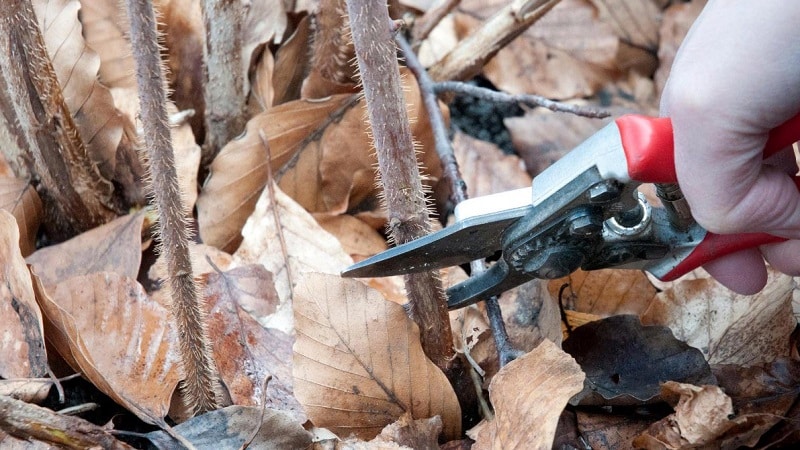
What does it give
Experienced gardeners recommend pruning raspberries.
What does the procedure give?:
- a larger number of buds are laid, as a result of which the yield increases;
- the growth of new shoots is stimulated;
- clutches of eggs and larvae of pests are destroyed;
- the penetration of light and air is improved, and pollinating insects have access to the inflorescences.
Timing of pruning
Raspberries need pruning, which cleans and shapes the plantation. Simple and remontant varieties are pruned at different times.
Timing of work:
- Cleaning pruning is carried out for all varieties. As soon as the berry picking ends, the fruiting branches are removed. In late autumn, starting in October, or early spring, in April, remove all broken and diseased shoots.
- Formative pruning is done in two steps for simple varieties. At the end of May, the tops of young shoots are pinched. After this, 2-3 side shoots grow on the branches. A month later, the regrown shoots are pinched again. The tops of remontant raspberries are not pinched.
Interesting things on the site:
How to prune raspberries correctly
The raspberry harvest directly depends on pruning. For the procedure to be beneficial, immediately determine the type of raspberry - simple or remontant.
This can be done using the following criteria::
- if the variety is simple, the berries are torn off along with the stalk;
- if the raspberries are remontant, the stalks remain on the bushes.
Simple and remontant varieties form different ways.
Attention! Simple raspberries bear fruit on last year's shoots, while remontant raspberries bear fruit on young shoots of this year.
For simple varieties, clean and double pruning is used.:
- Immediately after harvesting, the bushes are cleared of dry and broken branches. In late autumn or spring, after the snow has melted, last year's branches on which there was a harvest are removed. 5-7 strong shoots are left on the bush. In the spring, when the first buds bloom, cut off the tops of the branches to a healthy bud.
- Double pruning begins in June, when the young shoots have grown. At a distance of 80 cm from the ground, pinch the tops. In a month, 2-3 shoots will grow from each branch. In July, the tops of young shoots are pinched. The next year you get a lush, branched bush.
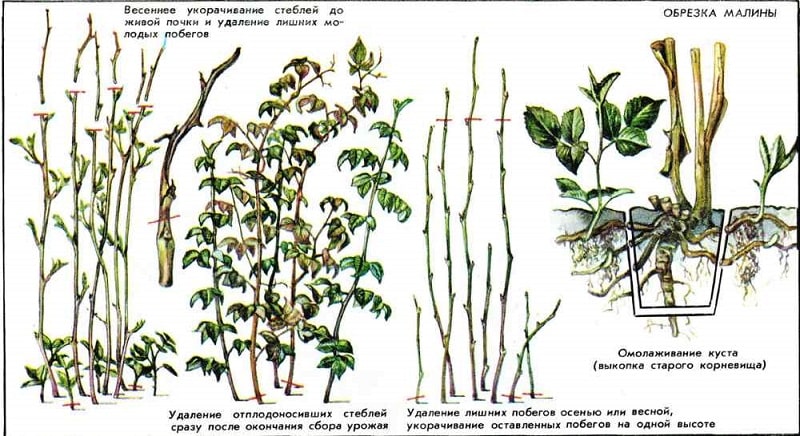
Required materials and tools
When starting to form bushes, you should take care of the tools. You will need garden scissors (secateurs) and gloves.
To clean the bushes, pruners are used to remove branches at the root. The tool should be sharpened to avoid damaging the plants.
Step-by-step instruction
We'll tell you in detail, how to prune raspberries for the winter:
- Cut branches at the root so that there are no stumps left.
- If there are seals on the branches, cut them out and burn them. These are pest larvae.
- Cut out lying and weak shoots - they take strength from the plant and shade the bush.
- Remove cut branches from the plantation to avoid attracting pests.
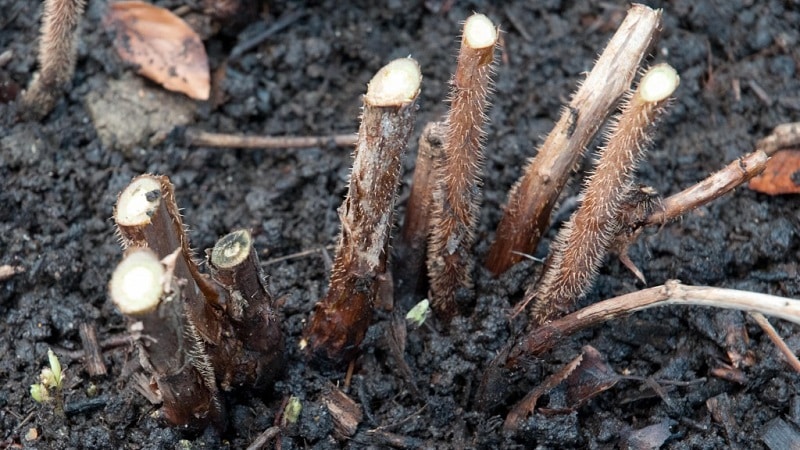
Types of trimmings
There are several types of trims:
- Partial recommended for remontant raspberries. It helps to have two harvests per season. In late autumn, branches that bear fruit are cut off. 3-4 young shoots are left in the bush. They are tied together and bent to the ground so that they do not freeze in winter. The roots of the bushes are mulched with straw or hay.
- Full used for remontant varieties to increase yield. Raspberries are cut in late autumn. Cut out the plantation at the root. It is important not to leave stumps. The following year, young shoots produce a bountiful harvest from August to October.
- Double used for simple raspberry varieties. It takes place in two stages. The first time - after the branches grow 80 cm, the second time - after a month. Pinch off the tops of regrown shoots. By the time of fruiting, a lush bush is formed.
- Pruning for sanitary purposes performed in early spring or late autumn. Frozen shoots are cut back to a healthy bud. Dry and damaged branches are removed.
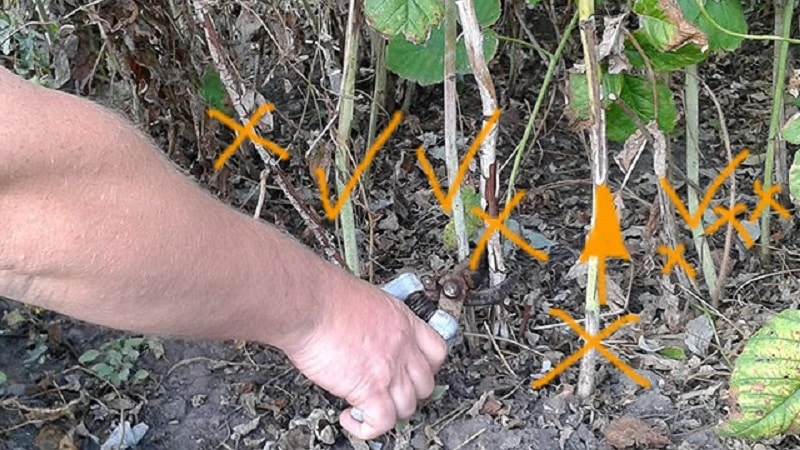
Features of pruning remontant varieties
Remontant raspberries are late varieties and produce crops on young shoots. The peculiarity of the crop is that it can bear fruit once or twice - it depends on pruning.
To obtain a harvest, partial pruning is done from June to October. In June, upon completion of fruiting, the tops of the shoots that contained the berries are cut off. A second harvest is formed on the growing young shoots. In the fall, when fruiting ends, the branches are tied and bent to the ground for the winter.
Important! The disadvantage of this method is that the plant spends a lot of energy on bearing fruit and growing shoots. In this case, the berries are few and small in size.
To obtain one harvest, the bushes are completely pruned in the fall.. After the end of fruiting, the bushes are cut off, leaving no stumps. The next year, shoots grow, on which berries are formed.
Benefits of full pruning:
- large berries grow;
- the yield increases significantly;
- absence of pests (at this time insects pupate).
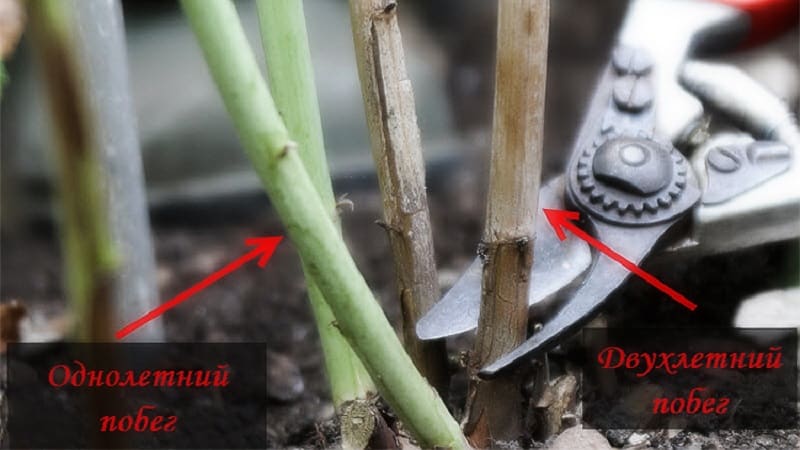
Nuances of pruning depending on the region
When to prune raspberries in the fall? It depends on the area in which the crop grows. The main rule is to be in time before frost.
In the southern regions of Russia The procedure begins in July and ends in October. These regions include the Republic of Crimea, Adygea, Kalmykia, Rostov, Astrakhan, Volgograd regions, Krasnodar region.
In outskirts of Moscow, where frosts begin earlier, care work begins in August and ends in mid-September.
In colder regions, the Urals and Siberia, work is carried out in August. Spring care of the plantation begins when the ground is free of snow.
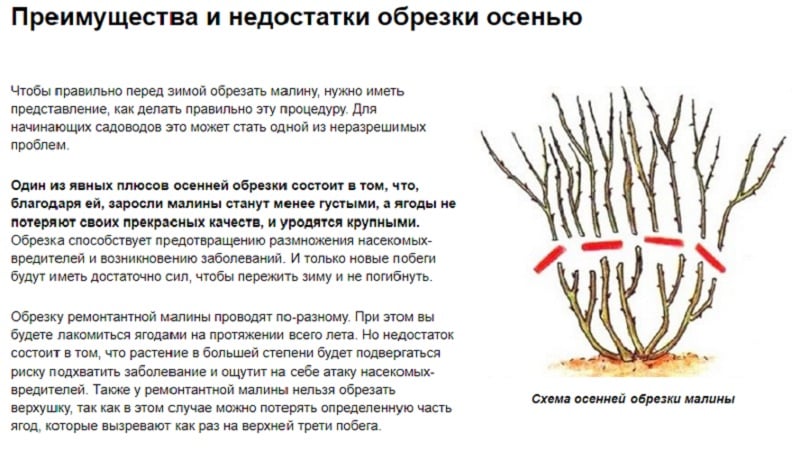
Caring for raspberries after pruning
Activities that will help the plant renew its strength and prepare for the next fruiting:
- Fertilizer application. During this period, raspberries need phosphorus-potassium nutrition.Complex mineral fertilizers are suitable: superphosphate (8 g), “Nitrophoska” (10 g per m²). Gardeners often use humus (8 kg per m²).
- Bending raspberries, which are not cut for the winter, to the ground so that the bushes do not freeze.
- Mulching the land for the winter with rotted manure, hay, and straw.
- Watering 1-2 times a week depending on the weather.
Read also:
conclusions
The pruning method depends on the raspberry variety. For remontant varieties, complete pruning is more suitable. This technology increases the yield and affects the size and taste of the berries. Double pruning is used for simple varieties. It helps increase the harvest by 3-4 times.
After pruning, you should apply fertilizer, mulch the soil, and water regularly. Proper agricultural technology will preserve the plantation for many years.